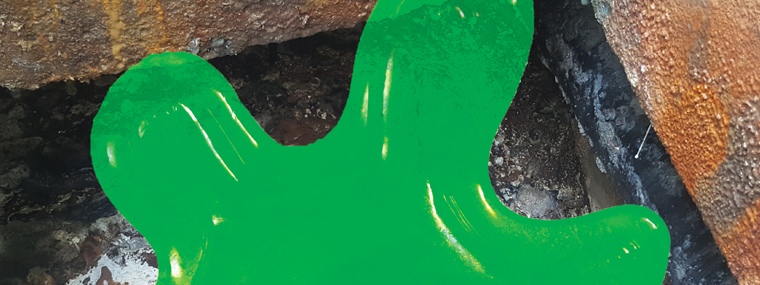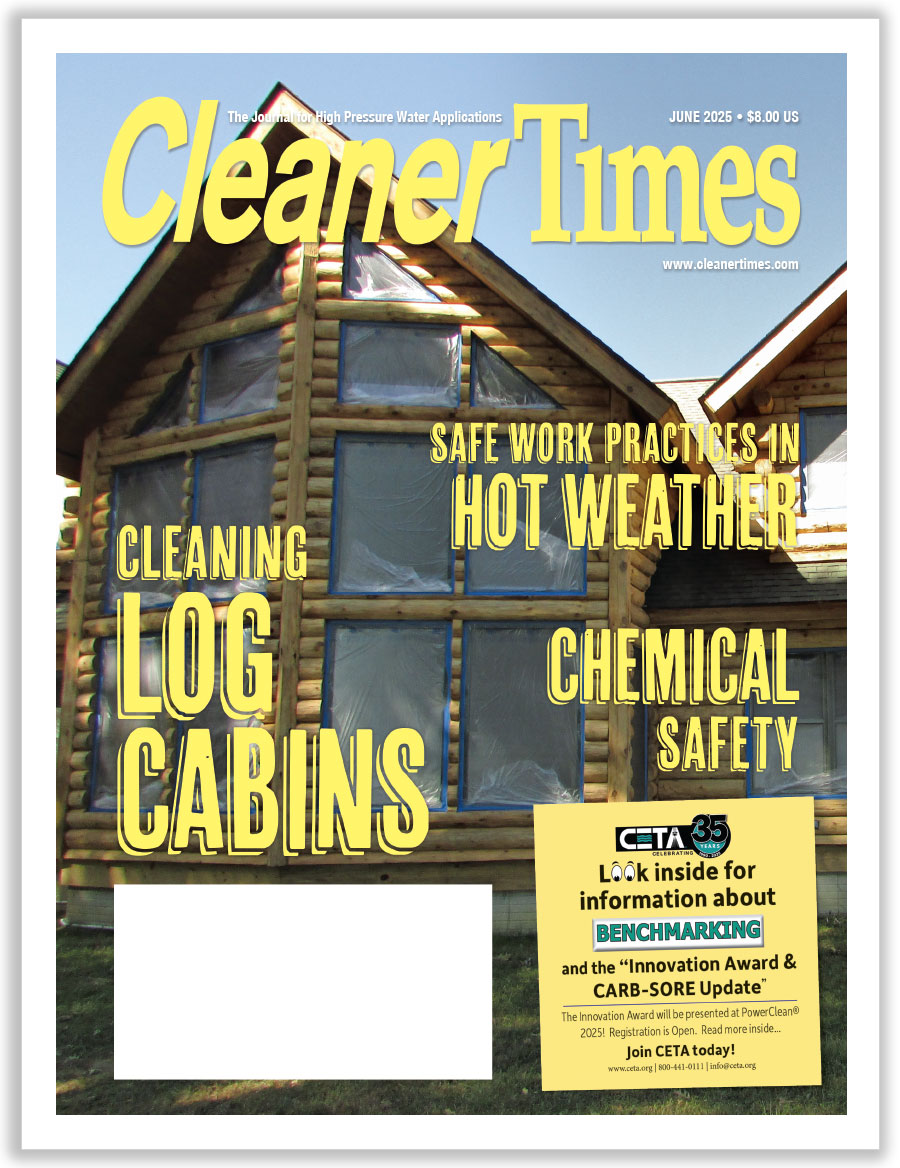
The Jobs You Can’t Forget
By April Hirsch / Published December 2019

Dirty Jobs
There are cleaning jobs, and then there are memorable cleaning jobs.
Exceptionally grimy or unusually soiled jobs often fall into the unforgettable category. The time required or the complexity of the job might put them there. So might an unsavory dimension tied to them.
“When asked about one of the dirtiest jobs we encounter, grease always comes to mind,” says Gene O’Neil, owner of Clean by Gene in Palm City, FL. “Not only can it be one of the dirtiest things to clean, it’s probably one of the most challenging.”
Moreover, a job with a lot of muck of any sort is difficult to complete without getting dirty. “Cleaning a dumpster pad in a confined area, especially one at a restaurant with an old fryer grease container, is surely going to get you dirty,” says O’Neil.
Jokingly, O’Neil says he sometimes questions whether restaurant employees can pour old grease into a container without spilling half of it. But grease cleanup is not the only dirty job.
“Removing mildew buildup and sand between pavers when preparing to seal can also be a dirty job,” explains O’Neil. “Yet, I think most would prefer a little dirt on them rather than grease.”
Irrespective of the type of dirt, making a good estimate of the time involved to accomplish the job is imperative. “I think many under-estimate the time required for many jobs,” says O’Neil.
Failing to accurately price every part of the task will lead to an estimate that is too low. “When cleaning, we’re removing algae, grime, grease, etc. from a surface, but where is the dirt going?” says O’Neil. “Even cleaning a simple driveway can sometimes leave you a mess to clean up.”
O’Neil points to the recovery systems that will be required for many tasks. He also cites the importance of considering the lay of the land before developing an estimate. “Evaluating drainage, the grade or slope of an area and low spots, is very important when factoring time required to complete a task.”
Dirt Differs
The second dictionary definition of dirt is earth or soil, as in the stuff that supports our vegetable and flower gardens. The first dictionary definition is the less-than-happy meaning of dirt. And that’s as it should be.
The word dirt derives from an Old Norse word (drita) that means excrement or skin. Think too much about that, and it’s easy to feel unsettled.
Contractors working almost anywhere have encountered some level of dirt that they will not soon forget. In some instances, though, complexity is more significant than dirt.
“My biggest job that overwhelmed me at first, and throughout the project, wasn’t necessarily the dirtiest, but it was the messiest for sure,” says Lucas Glanc, principal at Michigan Pressure Washing in Waterford, MI. “It consisted of massive multiple limestone retaining walls, some 20 feet tall, spread over an entire property.”
Glanc’s task was to remove all dirt, organic stains, and mud and rust stains. “Stones were stacked up unevenly, so there were many tricky surfaces to get to,” he explains. The water plus dirt created quite a bit of mud. That necessitated additional cleanup.
Although he has some reservations about turbo nozzles, Glanc says he used a turbo nozzle for the massive job. “It was the best tool, too, for this project.”
It’s all too easy to underestimate a job with unforeseen complexity, says Glanc. He did so on the limestone wall cleaning. “I underestimated the amount of surface that needed to be cleaned,” explains Glanc. “Re-rinsing it a couple of times to remove mud pouring from behind the wall took extra time, but choosing the right tool for the job—the turbo nozzle—cut down the work time required to finish the job.”
In fact, the turbo nozzle allowed Glanc to complete the cleaning in less time than he had anticipated. “I estimated this to be a two-day project, and I charged accordingly. But I was done with it eight hours later, including extras like two composite decks, a concrete patio, and a pool deck. In this case, choosing the right tools created extra profit and a very happy customer.”
Glanc’s experience with the retaining wall serves as a good reminder of the sort of balance contractors strike when estimating. “Even experienced contractors will make mistakes…some might not get what they need per hour,” says Glanc. “But sometimes luck turns the right and more favorable way. Wash on.”
Not Pleasant
Sadly, those who walk in highly urbanized—and even not so highly urbanized—cities know the odor of urine. Rats, dead and alive, are never shocking (but perennially distasteful). Then, there are encounters with blood, vomit, and who knows what. Someone has to clean it all up. It’s not pleasant.
“The ‘dirtiest’ job we deal with is cleaning anything that involves fecal matter,” says John Tornabene, the owner of Clean County Powerwashing in Kings Park, NY. “We cleaned kennels that were disgusting and parking garages that had urine and feces in the stairwells.”
Bad, yes, but not the worst. “The job that sticks out the most is a building we clean yearly. It’s right near a major airport, and on the rooftop, it gets loads of pigeon droppings and even dead pigeons lying around,” says Tornabene. “It was totally nasty, and it makes me feel nauseated just thinking about it.”
Tornabene explains that he would never make the sort of jobs he describes his niche market. He notes there are plenty of companies who do, and we should be appreciative of them.
“There are companies that come in to clean an area where someone died a nasty death, for example,” says Tornabene. It’s truly a job that must be done.
It’s always a must to get the time it will take correct when estimating a job’s duration. With the jobs that simply cannot be described as pleasant, it’s more of a must.
“Time is critical because time always equals money,” says Tornabene. “And while you can make great money cleaning these nasty jobs, if you underestimate the time, you could end up losing money in the end.”
To make sure there is a fair return on the “dirtiest” jobs, Tornabene charges appropriately. “I really don’t want my employees to deal with this unless the money is very good,” he explains.
Blood and Bleach
Body fluids—including blood, feces, and vomit—pose dangers. They may be contaminated with bloodborne pathogens. To be able to successfully clean areas where such substances are in the mix without risk, employees must be well trained.
Hazmat training of the most comprehensive sort now includes attention to bloodborne pathogens. For contractors who only rarely encounter the risk, there are plenty of quick refreshers.
For instance, the CDC offers the one-page fact sheet “Cleaning up Body Fluid Spills on Pool Surfaces” (https://www.cdc.gov/healthywater/swimming/pdf/cleaning-body-fluid-spills-factsheet.pdf). Bleach is the go-to disinfectant (nine parts water to one-part bleach, 20 minutes dwell time), but the sheet provides links to EPA- and FDA-approved commercial disinfectants. Protocol reminders about gloves, waste consolidation and bagging, and cleanup (bleach again) of any tools (e.g., brushes) are also given.
In settings such as hospitals, where cleaning puts employees into everyday contact with potentially infectious materials, OSHA has strict guidance (https://www.osha.gov/SLTC/etools/hospital/housekeeping/housekeeping.html). Contractors in our industry should be aware of some of the advice given for the hospital setting. For example, the hepatitis B virus can survive for one week in dried blood on surfaces and contaminated needles.
With blood and needles as part of the urban setting, contractors must be sure their employees take precautions to avoid contact when cleaning in challenging areas. Many states and municipalities offer guidance on cleaning items or areas that could include infectious materials. Use the USA.gov portal to search for a particular state. For a good example, see “Cleaning up Bodily Fluids and Human Waste” from the Salt Lake County (Utah) Health Department (https://health.utah.gov/wp-content/uploads/Human-Waste-Brochure.pdf).
Unique approaches to urban contaminants also can be found. California offers a Flea-Borne Typhus fact sheet emphasizing the endemic nature of flea-borne typhus (https://www.cdph.ca.gov/Programs/CID/DCDC/CDPH%20Document%20Library/FleaBorneTyphusFlier.pdf). The sheet notes those who live outdoors, such as the homeless, are at greater risk because they are more likely to come in contact with fleas that have picked up the typhus bacterium from rats, stray cats, and opossums.
The Golden State’s typhus fact sheet makes a good case for the importance of sanitation and best practices in waste disposal—keeping trash cans covered and keeping all outdoor areas clean and tidy. Unfortunately, some of the state’s policy measures, such as allowing outdoor living and unsanitary practices, contradict them. It’s vexingly complicated. Nevertheless, any contractors tackling such jobs should ensure they understand the risks and the time it may take to safely and successfully clean that particularly challenging and memorable job site.





